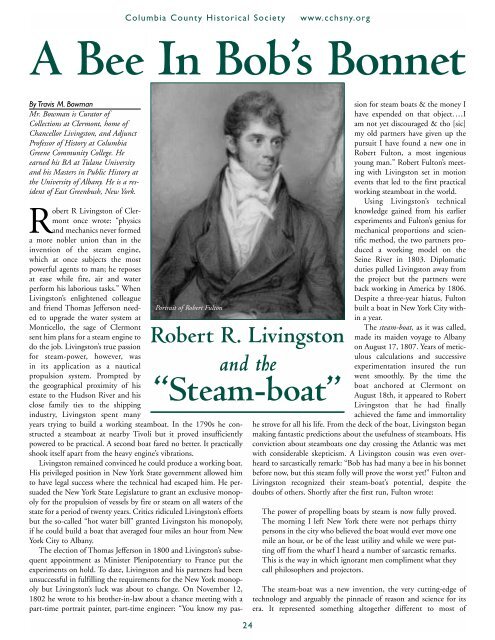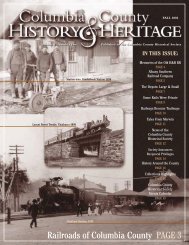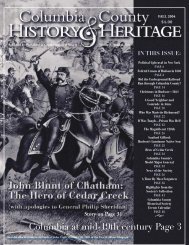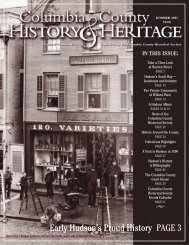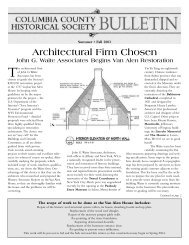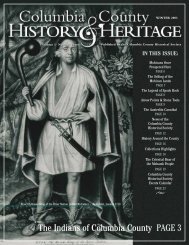Our Incrredible Valley Page 3 - Columbia County Historical Society
Our Incrredible Valley Page 3 - Columbia County Historical Society
Our Incrredible Valley Page 3 - Columbia County Historical Society
You also want an ePaper? Increase the reach of your titles
YUMPU automatically turns print PDFs into web optimized ePapers that Google loves.
<strong>Columbia</strong> <strong>County</strong> <strong>Historical</strong> <strong>Society</strong> www.cchsny.org<br />
A Bee In Bob’s Bonnet<br />
By Travis M. Bowman<br />
Mr. Bowman is Curator of<br />
Collections at Clermont, home of<br />
Chancellor Livingston, and Adjunct<br />
Professor of History at <strong>Columbia</strong><br />
Greene Community College. He<br />
earned his BA at Tulane University<br />
and his Masters in Public History at<br />
the University of Albany. He is a resident<br />
of East Greenbush, New York.<br />
Robert R Livingston of Clermont<br />
once wrote: “physics<br />
and mechanics never formed<br />
a more nobler union than in the<br />
invention of the steam engine,<br />
which at once subjects the most<br />
powerful agents to man; he reposes<br />
at ease while fire, air and water<br />
perform his laborious tasks.” When<br />
Livingston’s enlightened colleague<br />
and friend Thomas Jefferson needed<br />
to upgrade the water system at<br />
Monticello, the sage of Clermont<br />
sent him plans for a steam engine to<br />
do the job. Livingston’s true passion<br />
for steam-power, however, was<br />
in its application as a nautical<br />
propulsion system. Prompted by<br />
the geographical proximity of his<br />
estate to the Hudson River and his<br />
close family ties to the shipping<br />
industry, Livingston spent many<br />
Portrait of Robert Fulton<br />
years trying to build a working steamboat. In the 1790s he constructed<br />
a steamboat at nearby Tivoli but it proved insufficiently<br />
powered to be practical. A second boat fared no better. It practically<br />
shook itself apart from the heavy engine’s vibrations.<br />
Livingston remained convinced he could produce a working boat.<br />
His privileged position in New York State government allowed him<br />
to have legal success where the technical had escaped him. He persuaded<br />
the New York State Legislature to grant an exclusive monopoly<br />
for the propulsion of vessels by fire or steam on all waters of the<br />
state for a period of twenty years. Critics ridiculed Livingston’s efforts<br />
but the so-called “hot water bill” granted Livingston his monopoly,<br />
if he could build a boat that averaged four miles an hour from New<br />
York City to Albany.<br />
The election of Thomas Jefferson in 1800 and Livingston’s subsequent<br />
appointment as Minister Plenipotentiary to France put the<br />
experiments on hold. To date, Livingston and his partners had been<br />
unsuccessful in fulfilling the requirements for the New York monopoly<br />
but Livingston’s luck was about to change. On November 12,<br />
1802 he wrote to his brother-in-law about a chance meeting with a<br />
part-time portrait painter, part-time engineer: “You know my pas-<br />
Robert R. Livingston<br />
and the<br />
“Steam-boat”<br />
24<br />
sion for steam boats & the money I<br />
have expended on that object.…I<br />
am not yet discouraged & tho [sic]<br />
my old partners have given up the<br />
pursuit I have found a new one in<br />
Robert Fulton, a most ingenious<br />
young man.” Robert Fulton’s meeting<br />
with Livingston set in motion<br />
events that led to the first practical<br />
working steamboat in the world.<br />
Using Livingston’s technical<br />
knowledge gained from his earlier<br />
experiments and Fulton’s genius for<br />
mechanical proportions and scientific<br />
method, the two partners produced<br />
a working model on the<br />
Seine River in 1803. Diplomatic<br />
duties pulled Livingston away from<br />
the project but the partners were<br />
back working in America by 1806.<br />
Despite a three-year hiatus, Fulton<br />
built a boat in New York City within<br />
a year.<br />
The steam-boat, as it was called,<br />
made its maiden voyage to Albany<br />
on August 17, 1807. Years of meticulous<br />
calculations and successive<br />
experimentation insured the run<br />
went smoothly. By the time the<br />
boat anchored at Clermont on<br />
August 18th, it appeared to Robert<br />
Livingston that he had finally<br />
achieved the fame and immortality<br />
he strove for all his life. From the deck of the boat, Livingston began<br />
making fantastic predictions about the usefulness of steamboats. His<br />
conviction about steamboats one day crossing the Atlantic was met<br />
with considerable skepticism. A Livingston cousin was even overheard<br />
to sarcastically remark: “Bob has had many a bee in his bonnet<br />
before now, but this steam folly will prove the worst yet!” Fulton and<br />
Livingston recognized their steam-boat’s potential, despite the<br />
doubts of others. Shortly after the first run, Fulton wrote:<br />
The power of propelling boats by steam is now fully proved.<br />
The morning I left New York there were not perhaps thirty<br />
persons in the city who believed the boat would ever move one<br />
mile an hour, or be of the least utility and while we were putting<br />
off from the wharf I heard a number of sarcastic remarks.<br />
This is the way in which ignorant men compliment what they<br />
call philosophers and projectors.<br />
The steam-boat was a new invention, the very cutting-edge of<br />
technology and arguably the pinnacle of reason and science for its<br />
era. It represented something altogether different to most of


